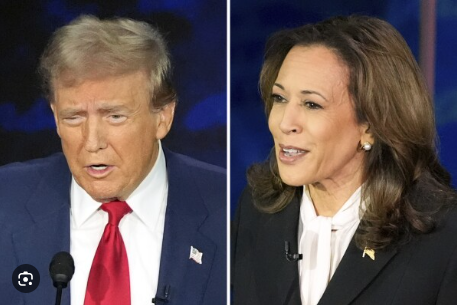With less than a year till the U.S. presidential elections of 2024, this is arguably one of those turning points in American history. The election is a high-stakes intensity for every eligible voter across the country as political, social, and economic issues dominate national conversations. The elections not only decide who will live rent-free in the White House for four years but also influence the direction of U.S. domestic and foreign policies. Running against each other were the two big names on the scene, Kamala Harris of the Democratic party and Donald Trump, the Republican candidate. This matchup promises to be one of the most significant and increasingly competitive elections in recent memory, with other opponents running for the position.
Kamala Harris: A Vision for Progressive Change:
As the first woman and first person of South Asian and Black descent elected Vice President, Kamala Harris has been registered into the presidential race with a vision for progress, equity, and social justice. Her policies focus on economic fairness, an expansion of access to healthcare, racial and social justice, and climate.
Economic Justice and Workers’ Rights:
Kamala Harris has consistently called for reducing income inequality and upholding the interests of working Americans. Included in her proposals are increasing the federal minimum wage, expanding the paid family leave available to workers, and policies to grow small businesses. The advocacy for policies that further narrow the wealth gap between the very rich and poor has included calls to tax the rich much higher as well as taxation for corporate entities.
Healthcare Access and Affordability:
Building on her record of supporting the ACA, Harris calls for expanding healthcare coverage. While she has endorsed a public option plan, she said that she would focus her campaigns on affordability and accessibility by pushing lower prescription drug prices and expanding insurance options for all Americans.
Climate Action:
Harris introduces herself as a strong ally in the fight against environmental hazards and climate change. Her campaign supports clean energy projects that will involve major investment in renewable energy sources such as solar and wind, through policies aimed at reducing carbon emissions. She also backs job initiatives that would support the transition of workers from jobs based on fossil fuels to more sustainable job opportunities.
Civil Rights and Social Justice:
The policies of Harris run the gamut, variously centered on the plane of race and gender. Harris herself has championed many policies directed to the challenge of systemic racism and discrimination, while also supporting her criminal justice reform campaign relating to law enforcement accountability and mass incarceration. Harris has added her voice to the chorus advocating for greater protections for LGBTQ+ individuals.
Donald Trump: The “America First” Approach
Donald Trump, the 45th president of the USA, remains a glowing figure in American politics. Re-election into the office by 2024 under the themes of making the economy more robust, increasing national security profiles, and confirming American values. His core theme of the campaign revolves around policies that create jobs, cut taxes, reduce regulations, and secure the U.S. border.
Economic Policy and Job Creation:
Central to Trump’s campaign is a return to the economic policies pursued in the first term: tax cuts for individuals and corporations, deregulation, and investments in American industry to stimulate job creation. A sharper, more focused protectionist trade agenda and a determined effort to bring jobs back to the U.S. in manufacturing have increased in priority, far beyond a vague desire for jobs to be brought back to America.
Immigration and Border Security:
Trump’s political franchise is essentially built on his immigrant issues. His campaign slogan is heavily focused on stances on immigration, such as bolstering security along the southern border, completing the border wall, and stopping illegal immigration by implementing laws aimed at putting a halt to those other than themselves. Such a regime to promote merit-based immigration has also been enhanced together with calls to stop sanctuary cities.
Law and Order:
Another consistent point in Trump’s first campaign was his concentration on law and order. His platform maintains that focus, especially on crime, policing, and public safety. Trump has advocated for a strong police presence and support for police reform that emphasizes giving officers more authority in addressing crime.
Foreign Policy: America First
Trump’s foreign policy during his presidency was an act of preserving America first; we must guarantee America’s sovereignty to assuage American Nationalists. In 2024, Trump’s foreign policy will be sympathetic toward economic nationalism, avoiding participation in multilateral agreements, and challenging such outsiders as China and Russia. With “America First,” it becomes about not only safety but also value.
Great Election, Great Choice:
The 2024 elections afford the electorate a distinction between two diverging visions of the future of America. Kamala Harris has a progressive agenda based on economic justice, healthcare access, climate action, and social equity. On the other hand, Donald Trump has a hand in what he believes could be a return to old-time conservative policies on economic nationalism, immigration control, and law and order type of governance.
Conclusion:
Former President Donald Trump has reached 270 electoral votes thus becoming the President of the United States. Having won, Trump shall now focus on economic issues, job creation, border security immigration, etc. While recoiling with the aftermath and valiant saga faced in the future, let the last question be: necessarily not how Trump shall work in the premises of the White House, but instead how our country shall behave to another chapter in its political history.


